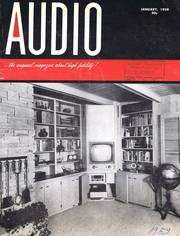Erläuterungen zu diesen US-AUDIO Seiten der 1950er Jahre
Die hier stehenden amerikanischen Artikel aus 1959 (aus der US-AUDIO) sind teilweise sehr gewöhnungsbedürftig, weil sie erstens aus einer längst vergangenen Zeit stammen und zweitens, weil dort in den USA ganz "anders" gedacht wurde als bei uns in Old Germany oder in Europa.
Vergleichbar mit unseren deutschen Hifi-Magazinen etwa ab 1962 ist jedoch, daß auch dieses Audio-Magazin ihre Anzeigen- Kunden und -Leser am Markt oder von anderen Magazinen (be- oder ab- ?) werben mußte. - Weiterhin sind die riesigen Dimensionen des amerikanischen Kontinents mit unseren hier in Europa nicht vergleichbar. - Ein Redaktions-"Trip" von New York nach Los Angeles oder Chicago oder gar in die Wüste nach Las-Vegas zu einer der CES- Audio- "Shows" war - auch mit dem Flugzeug - immer noch eine halbe Weltreise. Und jede Ausstellung oder "Messe" wurde als "Show" deklariert. Und natürlich, in USA musste alles "Show" sein, um beim Publikum einige Aufmerksamkeit zu erzeugen.
.
ABOUT MUSIC - "The Problems of Stereo Opera Recording"
von HAROLD LAWRENCE
Ever SINCE the production of the first complete opera on discs over a generation ago, it has been acknowledged universally that, from all points of view, opera poses the most challenging problems for the recording director.
The scope and variety of musical forces participating, for example, in a full-blown 19th-century Romantic opera are truly staggering to contemplate: a large cast of characters (including perhaps half a dozen principal singers), a chorus of some hundred voices, a 90-man orchestra, and, to add another dimension, several off-stage effects featuring soloists, chorus, band, and assorted solo instrumentalists.
Am meisten wird der Toningenieur von den menschlichen Stimmen - weiblich wie männlich - gefordert
To the engineer, it is no secret that the human voice, when lifted up in song, has a nasty habit of confounding meters: its output often fluctuates wildly, not only within a melodic phrase, but on a single note; and when multiple vocal chords are set vibrating simultaneously, it takes a clear head and nerves of steel to stand one's ground before the tonal onslaught.
Visualize a high-wire act performed by a pole-less acrobat, and you have a mental picture of the recording director attempting to strike the right balance between all the musical elements involved.
Und Stereo ist dann noch eine Nummer komplexer
The advent of stereo sets opera apart from other forms of recorded music. In recording a symphony orchestra, for example, the placement of microphones should be arranged so that the listener will easily sense the disposition of the instrumental forces and will perceive the dimensions of depth, directionality, and spread of sound. Once the best positions have been found, the microphones remain stationary throughout the sessions, as do the players, of course.
The only movement in stereo symphonic recordings is that suggested by the musical score itself: the upward sweep of the scale starting in the lower strings and ending in the first violins in the "Marche" from Tchaikovsky's Nutcracker Ballet races across the aural stage before us from right to left; the spotlight moves swiftly from trumpets to pizzicati strings, trombones, horns, cymbals, and bass drum in the "Danse des cochers et des palefreniers" from Stravinsky's Petrouchlca. Such lateral "movement" is strongly apparent in stereo reproduction, as are the effects of expansion and contraction of orchestral sound. Nevertheless, the actual setup of instruments is fixed.
.
Und ganz wichtig - auf die Stereo-Balance kommt es an
Balance problems in stereo symphonic recordings are largely, if not totally, solved before the first take is slated. From this point on, adjustments are made through musical means. (In multiple-mike sessions, the mixing panel takes over this function to a great extent.) If, for example, the string passage underlying a solo clarinet phrase is a bit too loud, the conductor will call for an even softer accompaniment; in another instance, the timpanist's quarter-note strokes may be too spongy in texture and he will have to resort to harder sticks.
Nur das Orchester ist statisch aufgestellt
To the producer of stereo concert music, balance is a continual preoccupation; to the stereo opera recording director, it becomes a near obsession (Zwangsvorstellung), for the latter has to contend with both fixed and moving performers.
The only stationary element in the stereo opera production is the orchestra; singers change positions constantly, performers are dispatched to a variety of remote areas for off stage effects, and even the chorus has no unalterably fixed position.
Der Aufnahmeleiter ist jetzt doppelt gefragt
Faced with this fluid situation, the recording director quickly finds himself doubling as stage director. Prior to the sessions, he must spend a considerable amount of time studying the score and the libretto in order to plan a course of stage action that will make dramatic as well as musical sense when heard in its finished recorded form.
He must decide on such mundane matters as exits and entrances, and whether a given character is to enter from the right or the left, so as to avoid having anyone pass through a wall (on the right) rather than walk through a door (on the left). A diagram of the stage set would come in handy at this point, as would a complete record of positions taken by each singer in the cast.
Die Reihenfolge der Akte ist nicht mehr wichtig
Since it is highly unlikely that the numbers in an opera will be recorded (auf Magnetband) in strict chronological order, it is therefore imperative to recall the singers' positions and movements so as to preserve logical scene-to-scene continuity.
This is particularly important in operas involving recitatives with cembalo accompaniment, which are recorded at non-orchestral sessions.
Close familiarity with the work as performed in the opera house is, of course, essential. If a certain character traditionally makes her entrance from the right in every known live production, it would be naturally inadvisable to introduce her from the left, just as it would seem strange to hear an orchestra with first violins and cellos reversed.
Inzwischen wichtig - die Positionen der Solisten
As in monophonic recordings, the first order of the day is to secure the best possible pickup for each voice in its solo and concerted positions. As soon as these positions have been determined, the floor is speedily marked with the following vital facts: singer, on floor or riser, pages of score, and angle of body in relation to the microphones.
For a test, the artist is requested to sing a given passage in "full voice." No one, however, seriously expects to get anything more than an approximation of the intensity of an actual performance, for it is a rare singer indeed who will not surpass his "test" output by a few decibels when the take is slated and the tape machines are rolling. Consequently, a final adjustment is usually necessary at the last moment.
The position of a singer is also dictated by the nature and power of his vocal production as picked up by the microphones. There is no question that some voices are more phonogenic than others - that is, they are easier to place than most. It can be rather tiring for one such phonogenic artist to repeat his part in a scene over and over again while his partner is being sonically "fitted." Only after these basic positions have been discovered can the recording director concern himself with stage movement.
.
Drei Herangehensweisen bei den Aufnahmen
There are three main approaches (Herangehensweisen) to action in stereo opera. The first favors unlimited movement, not only in places in the score in which a specific change of position is indicated, but even in arias (in Arien).
According to this approach, the singer should behave at the session as he does on the stage during an actual theatre presentation,- if he feels like moving his head from side to side, twisting his body in a lively dance, or even stepping forward or backward, nothing should restrain him from doing so for the sake of realism.
The second approach involves a cast of characters spread out across the stage, but glued to their assigned positions; this might be described as stereo opera in white tie and tails.
The third approach falls somewhere between the two extremes. Movement here is supplied when called for to underline the drama, and to indicate changes of position, exits, entrances, asides, and so on, but it is not employed at the expense of intelligibility and aural focus. Regardless of the degree or manner in which it is used, movement in stereo opera is here to stay and brings the theatre's visual and dramatic impact closer to the listener than ever before.
.



